#people will try to be 'objective' and 'narratively-focused' in character evaluation unless it's her
Explore tagged Tumblr posts
Text
All the time, I hear about how there are people filtering Cersei through the lens of "poor misunderstood woobified victim who was trying her best and never actually did anything bad" and. WHERE ARE THEY?? WHERE ARE THESE PEOPLE?????
BECAUSE THIS HAS VERY MUCH NOT BEEN MY EXPERIENCE
#like I have no doubt that they exist somewhere#but I have never seen them!#90% of what I see is 'I hate her because she's a one-dimensional bitch and here are all of the horrible things I think she deserves'#I always wonder if these people are talking about me even though it would make no sense for them to even know I exist#(<-girl who notably does not often tag her cersei posts)#but. me saying 'here's where I think she was coming from' or 'sometimes she'll say something and I'll go 'yeah I get it' ' or 'there is#something very visceral and real and compelling and relatable about her' is not. me saying that she is a good person lol.#I have on several if not many occasions specifically mentioned how she is not A Good Person™ and that#I understand if her flaws make people uncomfortable.#(but I also talk about how I don't understand what makes her uniquely awful compared to other popular characters across various#franchises so I. again. DO wonder if the 'people excuse everything she did ever and think she's Good™' comments refer to me sometimes)#ANYWAY. the point is that people have sympathy for horrible actions when they come from anyone else but not from her hmmm gee I wonder why#people will try to be 'objective' and 'narratively-focused' in character evaluation unless it's her
3 notes
·
View notes
Text
What “stories” is Mary referring to?

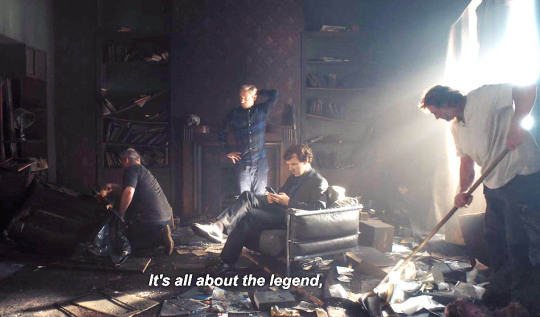


OK, of course, I see; that’s it – the stories. Conan Doyles’ amazing detective stories at the hands of our “Baker Street boys” have once again been interpreted into a new adaptation, this time played out in our own modern times. But it’s still about these wonderful stories; nothing else matters.
But wait – what ‘stories’ exactly do you refer to, Mary / AGRA / Rosamund / Gabrielle-or-whatever-your-name-is? Series 4 may have lots of Conan Doyle canon references, but why doesn’t it have a single coherent crime story? Not one!
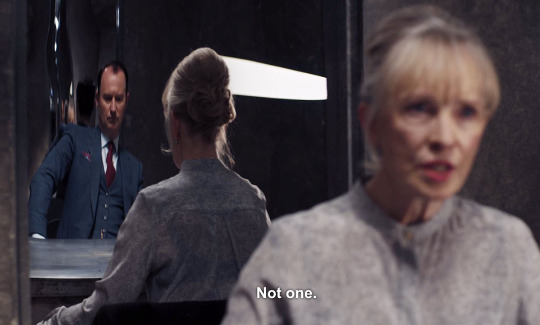
If the cases were that important, wouldn’t we be able to follow them as they unfold, basking in the brilliance of these fascinating adventures and their clever resolutions? Or at least be privy to some logical deductions and conclusions about them from the great detective Sherlock Holmes, narrated by his loyal friend Dr John Watson?
I think the ‘stories & adventures’ approach, in a traditional meaning, might be valid up until the beginning of Series 3, but then the coherent plot line gets abandoned in favour of a rather different content. Which means Mary’s words about ‘stories’ above may not be relevant. So – why not take a closer look at all of this show’s stories to see if they actually merit the name? I’ll go through all of them one by one since Series 1, focusing on the factual events in them, trying to evaluate their narrative interest as plot line and see where we end up in S4. I will try to not go into any personal issues for Sherlock Holmes or other characters – just the stories, as ‘objectively’ and free of Sentiment that I’m capable of. (And this is a monster post, so please bear with me).
For a start: A Study in Pink in Series 1 gives us the background where Holmes first meets former army doctor John Watson, whom he offers to be his flat mate. Watson moves in and Holmes takes him on their first ‘adventure’ - a creepy crime story of a serial killer cabbie who ‘persuades’ his victims to commit suicide. His MO is to lure them into his cab, drive them to some remote location and threaten them to play Russian roulette with him by taking pills. Holmes helps the police (New Scotland Yard) with the case, but some of them distrust Holmes, and when he withholds a piece of evidence, they come to Holmes flat on a drug bust (finding nothing). Holmes does solve the case, however, and we are privy to his impressive deductions to get there; one of them involving the pink colour of a missing suitcase and another a desperate clue from a dying victim to find her murderer. Holmes gets in personal grave danger from the cabbie, but Watson saves him in the last moment by killing the culprit. Fair enough; I think this is a really good, intriguing detective story!
Next: In The Blind Banker Holmes and Watson get involved in a crime case with a mystic killer, who murders his victims in rooms locked from the inside (making it look like suicides). Cracking ciphers and codes and doing interesting deductions that we can follow, Holmes solves this one too, with some help from Watson. It turns out there’s a Chinese crime syndicate behind the murders, dealing with drugs and ancient stolen treasures, and a killer “spider man” who climbs buildings to execute their murders. Holmes, Watson and a third person get in serious trouble, but Watson saves the day in the culmination of the adventure.

Interesting story, I’d say (if it weren’t for the rather prejudiced depicting of Asian people, perhaps…)
Series 1 culminates with The Great Game, where a super-villain manages to get Holmes’ attention by wrapping his victims up in explosives (as if they were suicide bombers) and make the detective solve other crime puzzles to save their lives. Every puzzle is marked by a ‘pip’ on a mobile phone, five of them in total. Holmes solves all of them (among them a case of “national importance”, involving a stolen secret memory stick that his brother wants recovered for the government). At the end Watson is kidnapped and wrapped in explosives to threaten Holmes. He doesn’t defeat the super-villain, which makes for a nice cliffhanger. The stories are thrilling and exciting, and the deductions are made clear to the audience.
First out in Series 2 is A Scandal in Belgravia, where a ‘femme fatal’ Dominatrix is working on Holmes to deceive him through ‘Sentiment’. The case starts with Holmes’ mission to recover some compromising photos of a royal person from the Dominatrix’s locked camera phone. But it soon turns into a case where the government (and the CIA) is trying to lure international terrorists into a trap by sending up an aircraft full of dead corpses for them to blow up. The Dominatrix (who is actually working for the super-villain) is supposed to make Holmes crack the code to the governmental operation in order to warn the terrorists. Which he does, with an amazing deduction that ends in:
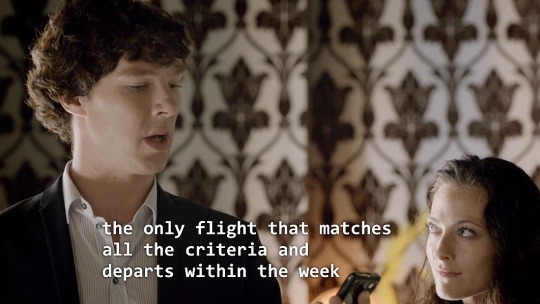
She succeeds in this by getting his emotional attention, but Holmes defeats her in the end by breaking into her camera phone, and hands her secrets over to the government. In this episode Holmes also solves some other crime puzzles, some of which are told as mere fragments (if we want to know more about them, we can read John Watson’s blog). The main narrative is a bit confused and convoluted, but I’d still say it’s a good, coherent story.
The Hounds of Baskerville is perhaps the story that is most similar to Doyle’s original. Holmes and Watson travel to Dartmoor to solve a case in which the young client Henry Knight thinks he’s going crazy. Henry believes a legendary gigantic hound was the killer of his father 20 years earlier (a crime he witnessed as a child), and he’s having creepy visions and sightings of this monster. Holmes suspects that the nearby top-secret military laboratory Baskerville is involved in the supposed appearances of the hound. Genetic cloning experiments with animals at Baskerville are suspected at first, but then Holmes concludes that the Hound is partly a figment of people’s imaginations. Henry Knight turns suicidal, but Holmes’ deductions save him in the last moment and the murderer who has been ‘gas-lighting’ Henry (a scientist at Baskerville) is revealed. When people’s sightings of a big, salvaged dog on the moor combines with the effect of a hallucinatory drug applied by aerosol, the result is the impression of a monster. Holmes’ deductions are presented for the audience to follow step-by-step, accompanying the plot line. This is a classical, fascinating detective story.
In The Reichenbach Fall the super-villain is back again, this time with an elaborate plan to disgrace Holmes and drive him to suicide. He starts by committing a series of sensational crimes and gets away with them in spite of overwhelming evidence, just because he can. His plans also involve poisoning children and make them fear the very sight of Sherlock Holmes. Holmes finds the kidnapped children through chemical lab analysis of their traces and clever deductions (which we can follow). But then Holmes get blamed for this crime and others, after the villain has influenced a tabloid scandal journalist. Four snipers are placed in Holmes’ neighbourhood, ready to kill Watson and two other of Holmes’ closest friends, unless he throws himself from a rooftop.
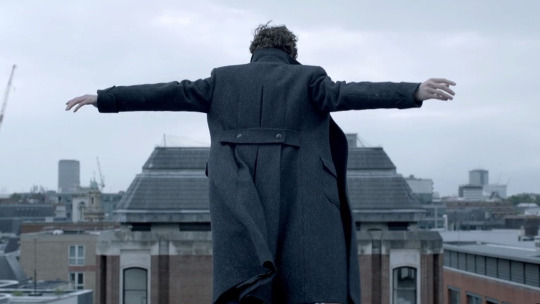
The villain shoots himself in the head, but this only permanents the sniper threat; Holmes has to jump. At the end of the episode, the audience knows that Holmes must have faked his death and somehow survived the fall, but we’re left to figure out how. The story line is thrilling, coherent and easy to follow.
Series 3 and The Empty Hearse starts with an explanation of how Holmes survived “The Fall”. This, however, is where the plot line starts to derail and lose credibility. We never get to know the real events of Holmes’ fall, but are introduced to a Holmesian Fandom within the series, with their respective versions of how the detective survived, one of them more outrageous than the other. Holmes, who has spent two years traveling around to dismantle the super-villain’s network, is captured and tortured by Serbian criminals wearing WWII Red Army uniforms. When he gets back to London, however, he doesn’t seem to be the least bothered by his wounds. He gets involved in a case concerning a skeleton and a book by Jack the Ripper, which turns out to be a fake crime arranged by a former police officer (same guy who accused Holmes of being a fraud in the previous episode; what was his motive?).
Watson, who is reluctant to forgive Holmes for having played dead, gets drugged, kidnapped and tied up in a bonfire (we aren’t told by whom), but Holmes finds out where he is kept (through cracking a skip code), and sets off to rescue Watson. The main story about a planned terrorist attack on London is sketchy, to say the least (I’m afraid reality vastly surpasses BBC Sherlock fiction when it comes to terrorist attacks). We are allowed to follow some of Holmes’ deductions to locate a bomb in the subway, but several plot holes become evident: When did Holmes call the police?
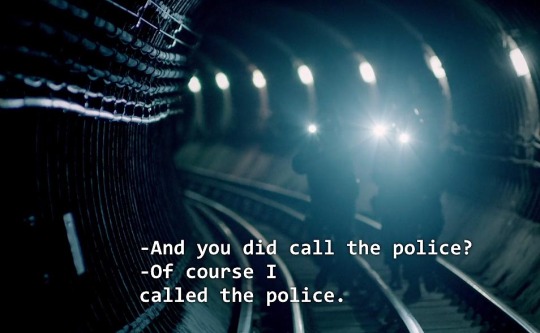
Why did Holmes and Watson go down in the subway to diffuse a bomb with their bare hands? Why did the bomb have an off-switch, when no-one was supposed to be there when it exploded? Which organization was behind the attack? What were their motives? The plot seems secondary in this episode!
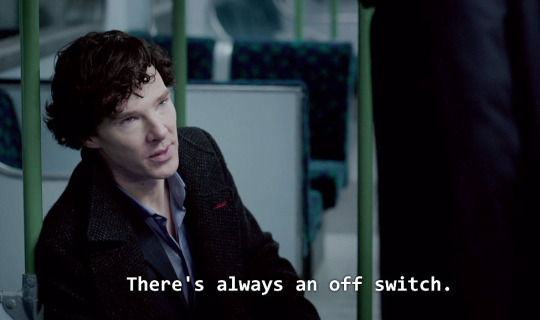
The Sign of Three focuses entirely on Watson’s wedding, and Holmes - who hates social gatherings - abandons his work in favor of a full-time commitment to plan the reception, down to the tiniest details of table decorations and who is to sit together with whom. None of these details turns out to be relevant to the story, however (plot-wise: WTF?). We’re now told in Holmes’ best man speech that his and Watson’s adventures are “frankly ridiculous”.
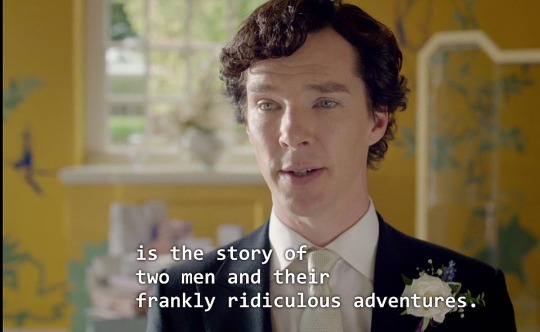
We do see flashes of cases to entertain the guests, but the only more or less coherent case happens on the wedding reception. Most deductions now take place inside Holmes’ head - his so-called Mind Palace. It turns out that the wedding photographer tried to murder one of the guests by stabbing him in the waist from his backside with a thin blade, while rehearsing for a group photo. The victim is supposed to not have noticed the stabbing until he took off his uniform belt (WTF?). When the victim is informed of this he threatens to commit suicide by removing his belt, which Holmes manages to talk him out of, so Watson can give him medical treatment. The photographer is captured; Holmes makes one more deduction about Watson’s wife being pregnant (which none of the parents are aware of?) and leaves the party early.
His Last Vow is the series final and plot-wise the most problematic episode, many times crossing the border of credibility. I’d definitely call this “frankly ridiculous”; it seems to contain more plot holes than a Swiss cheese and the kind of fantastic exaggerations one might expect from someone high on drugs.
Holmes is engaged in a blackmail case, involving prominent members of the government. The blackmailer is a powerful media magnate. Watson and his wife go to a drug den to rescue their neighbour’s son, where Watson also finds Holmes lying on a mattress. They take him to a hospital lab to test his blood for drugs. Holmes claims his drug use is for the blackmail case, which his friends dismiss. Members of Holmes’ fan club search his flat for drugs (sounds illegal to me), but find nothing. Later the blackmailer visits Holmes, intimidating him and showing him the letters he is using to put pressure on Holmes’ client. Holmes and Watson go to the blackmailer’s office later that night, to recover the letters. They manage to get through the security with help from the black-mailer’s PA, whom Holmes has a fake relationship with and fake-proposes to. (How she can buy this is an enigma, but that’s food for another meta).
Inside the office they find Holmes’ ‘fiancée’ unconscious on the floor. They smell a perfume that both Watson’s wife and Holmes’ client use. Holmes interrupts a scene where Watson’s wife is threatening the blackmailer at gunpoint. She turns out to be an assassin who is being blackmailed, but when Holmes offers help she turns the gun on him and shoots him in the chest.

In a matter of seconds, Holmes uses his Mind Palace to try to find advice on how to survive the gunshot. Watson finds him, takes him to hospital and Holmes ‘flat-lines’ on the operation table, but somehow he manages to restart his own heart (?). We then see Watson’s wife entering Holmes’ hospital room, threatening him to keep quiet. Later the ‘fiancée’ (already fully recovered from the blow to her head that rendered her unconscious), visits Holmes, fiddles with his IV morphine and shows him how she, as revenge for his fake proposal, is selling stories about their supposedly intensive sex life to the tabloid press (why would fame as a sex-god be a punishment?)
Somehow, shortly after this, the seriously injured and recently operated Holmes manages to flee the hospital room and arrange a whole scene of revelation to Watson. He escapes through the window, buys a bottle of perfume, travels to Baker Street, moves back Watson’s heavy chair, places the perfume beside it as a clue and calls Watson at the same time he discovers the clue. Together with Doctor Watson (who apparently is OK with Holmes leaving hospital) he travels to the fake houses of Leinster Gardens and arranges a set-up for Watson’s wife, involving her highly enlarged wedding photo projected on the walls. Not bad for a man recently shot in the chest, is it? ;)
When she arrives, she (unknowingly) reveals in front of Watson that she shot his best friend, having no remorse about it. Holmes orders them back to Baker Street to “sort it out quickly”, because they “have work to do” (what work?).
Oh dear storyteller, what did you take? Did you make a list? Anyway, the ‘story’ continues at Baker Street: Holmes is crumpling from pain, but there are no painkillers. Doctor Watson throws a tantrum and threatens his injured friend. Holmes makes excuses for his killer with some of the most ridiculous ‘deductions’ I’ve seen in the whole show. Then the meddlesome bastard (sorry, couldn’t resist – Sentiment got the better of me), before being taken back to hospital in an ambulance, goads Watson to trust his assassin wife claiming that she saved his life, at the same time as he accuses Watson of being attracted to this sort of people. The timeline jumps backwards and forwards between this scene and Christmas at the Holmes family House where Watson reconciles with his wife, while claiming that he doesn’t want to know who she really is an burns the memory stick she has given him with this info.
For the first time in the show, Holmes utterly fails to solve a case, leading to the suicide of his client’s blackmailed husband. Holmes and Watson go to the blackmailer’s luxury house to make a deal for Watson’s wife, but when things don’t go as he had planned, Holmes shoots the blackmailer in the head. (Where are his clever deductions to solve a tricky case? Since when is Holmes a murderer? Where is the coherence of this story? I’m loosing track here). The episode ends with Holmes being sent away on a private jet to a suicide mission in Eastern Europe, but he is immediately called back when the dead super-villains face is suddenly projected on every TV screen in the country.
The Abominable Bride is called a “Special” episode, since it mostly takes place in a Victorian setting inside Sherlock Holmes’ head. He re-plays his first meeting with Watson in the Victorian environment, and then starts to solve crimes involving a murderous bride who fakes her own suicide and re-appears as a ghost.

There’s also a conspiracy of women in hoods, having some sort of cult connected to the ghost bride, in a desanctified church. The dead super-villain shows up trice, challenging Holmes and drawing his attention to the fact that he’s dreaming. On two occasions Holmes seems to wake up on the private jet after severely overdosing drugs, met by Watson, his wife and Holmes’ brother. But they never really take him to hospital, and when the episode ends Holmes is still in the Victorian setting. All in all, the plot line’s total lack of coherence and logics is fully explained by it all happening in a drug-induced, dreamlike state inside Holmes’ head. So even if the actual story is missing here, I find this episode far more ‘logical’ than HLV.
The Six Thatchers marks the start of Series 4, and the plot lines (there are more than one) are bizarre, to say the least. In fact, it’s so weird and illogical that I would definitely not call this a ‘coherent story’.
First of all we see how the government covers up the fact that Holmes now is a murderer, supposedly so he can work on the case of the super-villain’s return with top priority. But he never solves anything about the super-villain; this whole plotline seems to just vanish!
Instead, there’s this other case where the corpse of a young man is found when his car explodes, having been dead for a week. Holmes explains to the shocked parents that the boy had disguised himself as a car seat, as a practical joke on his father’s birthday, when he suddenly had some sort of fit and died on the spot. Holmes’ deductions seems like wild speculation with next to no evidence. Why would this guy go to the trouble of finding a vinyl car seat disguise (where do you get such a thing by the way?) to surprise his father, when he could easily just have hidden in the dark of the back seat? And how likely is it that in this precise moment, he would have ‘some sort of fit’? But suddenly Holmes’ ‘prickling of thumbs’ are valid, rather than his hallmark logical methods.
At first the other plot line is similar to Arthur Conan Doyle’s story The Six Napoleons: Six plaster busts of Thatcher are smashed, the owners have the same names as ACD gave them, one person is murdered and Watson is suggesting that the culprit has an idée fixe. However, instead of discovering the precious Pearl of the Borgias in one bust, which was the canon case and what Holmes also expects this time, we end up with – a memory stick about Watson’s wife and her gang of assassins? The culprit of the smashings is another member, and he accuses Watson’s wife of treason in an earlier operation when they worked for the government. When Holmes meets up with her for an explanation, she drugs him with some sort of dust from a letter, which he deliberately sniffs on, and she disappears.
Then we follow Watson’s wife on her escape through many countries under several aliases. At one point she knocks out (kills?) a stewardess and steels her identity. When Holmes and Watson find her in Morocco (through a tracker on her memory stick) everything is forgiven without discussion, and Holmes swears to protect her. Instead of Watson’s wife, Holmes accuses a member of the government of treason.
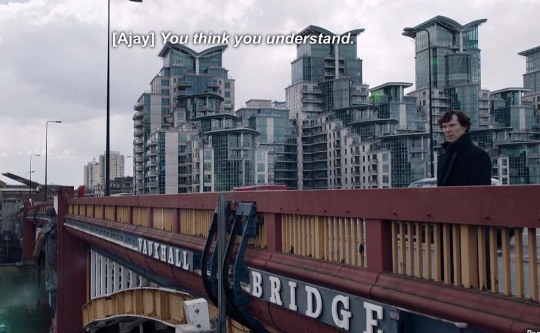
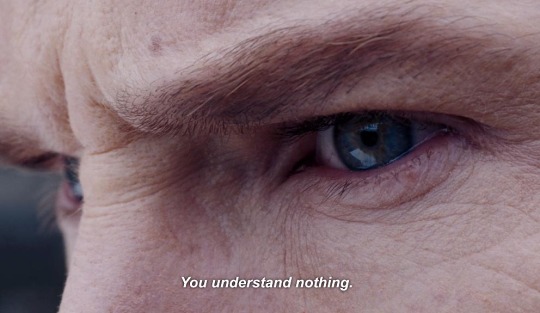
But he is wrong (again) and the traitor turns out to be a governmental secretary, who also tries to shoot Holmes. Seeing this, Watson’s wife somehow manages to move faster than the bullet (??) and takes it for him. In a long speech, with a bleeding wound in her abdomen, she declares her eternal love for her husband and, for the first time, apologizes for shooting Holmes. Then she dies. For some odd reason Watson blames Holmes for her death, and cuts all contact with his best friend. But John’s wife leaves behind a recorded DVD with a strange message where she tells Holmes to go to hell to save John Watson.
In The Lying Detective many elements are taken directly from Conan Doyle’s The Dying Detective: Mrs Hudson seeks out Watson to tell him that Holmes is in a very bad shape. We then see him in a haggard state, babbling deliriously, and we learn, along with Watson, that Holmes is dying.
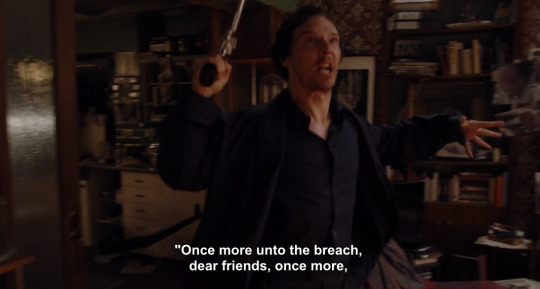
This picture of Watson looking at Holmes’ hospital bed...
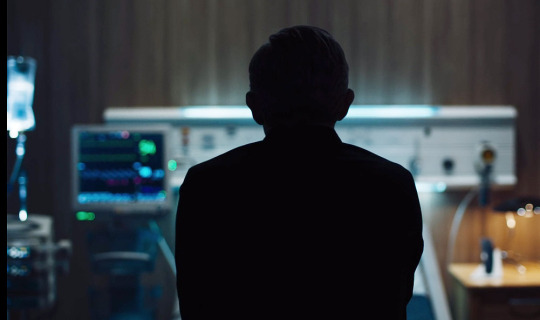
...fits nicely with this quote from ACD canon: “I had stood for some minutes looking at the silent figure in the bed”.
Holmes then lures the criminal, Culverton Smith, to confess that he is trying to kill Holmes. At the end of the story, Holmes takes Watson out for dinner (“cake” in TLD).
However, while Conan Doyle’s version is a perfectly coherent crime story, TLD is not. Doyle has Holmes explain the actual crime case: the murder of Smith’s nephew Victor Savage. Holmes has figured out that Smith killed Savage by poisoning him with a mortal disease. Holmes’ disguise is just a setup to make Smith confess, while gloating over both Savages’ and Holmes’ death.
On the other hand, in TLD, Holmes claims that Smith is a serial killer; he calls him “the most dangerous, the most despicable human being that I have ever encountered” and he shoots pictures of Smith on the walls of 221B. But who did this ‘monster’ kill? We don’t get to know about a single victim! Lestrade seems nauseated when Smith keeps confessing, but we never, ever get to know what the man has actually done. The only killing in TLD is instigated by Holmes himself; Holmes has told Smith that he wants Smith to kill him. And Holmes’ purpose with this is to make Smith confess that he is trying to kill Holmes. Redundant, isn’t it? What kind of ‘crime story’ is this? Holmes later tells Watson in TLD that the recording device he has used (hidden in Watson’s cane) qualifies as “entrapment”, which invalidates the confession. But since Smith supposedly has kept confessing other crimes (which we aren’t privy to) that’s enough to have him arrested. In canon Watson serves as a witness to the confession of the Savage murder, which is just what is needed to get Smith arrested. But in TLD Watson comes to rescue Holmes from a self-inflicted attack - in other words: Holmes’ suicide attempt.
In general, the other plot lines of TLD are even more ridiculous than in T6T, and the episode is perforated with plot holes that are never explained. Which is why I prefer to present them as questions below:
Why is Euros Holmes (Sherlock’s hitherto unknown sister) disguised as her brother’s suicidal client who walks the streets of London with him, only to suddenly leave him alone? Why does she fake being suicidal in the first place? Why has she disguised herself as Watson’s new therapist? Why does she want to capture Watson?
Why is Watson haunted by a ghost of his deceased wife? Why so much focus on Watson’s wife in general, even when it doesn’t move the plot forward in any sense?
If Mrs Hudson were worried about Holmes’ health, why would she put him handcuffed in the boot of a car and drive like crazy? And why would the guys from the café drop Holmes twice “because they know you”?
Why would Molly Hooper bring an ambulance when going to examine a patient? Since when does she even do medical consulting; isn’t her expertise post mortem? And after her diagnosis that her patient is dying; why don’t they take him to hospital to help him rather than having him answer questions to a bunch of kids?
Since when does Watson do deductions (here in the form of his dead wife in his head doing deductions) to figure out how Holmes does deductions to predict Watson’s future plans? Couldn’t Watson otherwise just – I don’t know – plan them? And how the heck can Holmes predict future events involving actions of various people in detail and with an exact timing?
What happened with TD12, the memory-altering drug; weren’t they actually going to use this plot device?
How can Watson assault Holmes, beat him to a pulp, be captured by the hospital staff, but then it’s suddenly said that Holmes has made a mess of himself?
How can DI Lestrade know about Holmes shooting the blackmailer in HLV, when that was supposed to be highly classified information?
Sorry Mary, but I can’t see even the trace of an actual story or adventure here, since none of all these questions is answered satisfactory. And the characters are so distorted, compared to how we know them from before, that the plot line gets extremely confusing.
The Final Problem is presented as if it was the last episode of BBC Sherlock, but this is never actually confirmed by the writers. As for the plot line, it’s so ridiculously convoluted, surrealistic and inconsequent that I simply refuse to call it a “story” at all; it’s much more similar to a nightmare.
When Holmes has learnt about Euros - his hitherto unknown sister - he sets up some sort of horror theatre with clowns, bleeding portraits and other tricks to scare his brother into telling him the truth.

We learn that Sherlock Holmes’ brother Mycroft as a teenager took to incarcerate their mentally ill sister in Sherrinford - an isolated, top-secret fortress out in the sea. Their parents thought she was dead (never investigated?) and Holmes has, strangely, forgotten all about her. While Mycroft is telling Holmes and Watson this in 221B, a drone flies in with a patience grenade that will explode if anything in its surroundings moves. Holmes and Watson jump out of the second floor window as the apartment blows up, but we never see them land on the pavement below. Instead they suddenly appear - without a scratch - on a fishing boat heading for Sherrinford. They highjack the boat, claiming they are pirates and, together with Mycroft, sneak into the fortress in disguises.
Pretty soon it gets clear that the dangerously intelligent Euros has taken over the fortress and manipulates people into doing her bidding. The persons Holmes and Watson have met as “Faith”, “E” and John’s new therapist are all one and the same person; Euros in disguise. Euros starts to perform a series of cruel experiments on Watson and the Holmes brothers. First she tries to force one of them to kill the governor of Sherrinford, threatening to kill his wife otherwise. When none of them can do this, the governor shoots himself, and then Euros kills his wife anyway. Next she shows them three men, bound and dangling from a cliff. She forces Sherlock to figure out who of them is guilty of murder, but when he obeys she kills all three. In the next experiment Euros has Sherlock phone Molly Hooper and make her say “I love you” to him – otherwise her flat will be blown up. But Molly doesn’t know this, and before declaring to Sherlock, she makes him say the same thing to her. Sherlock thinks he has won this one, but Euros claims that he has only managed to hurt Molly (who is in unrequited love with Sherlock).
All the time at Sherrinford, Holmes has somehow been in voice contact with a frightened little girl who is on-board a jet plane in the air, full of sleeping adults (including the pilot). He tries to get information from this girl, but their communication is constantly interrupted by Euros.

In the fourth experiment Sherlock has to choose between killing either Watson or Mycroft. Instead he chooses to shoot himself, but Euros stops him with a tranquilizer arrow. He sinks into a black liquid and wakes up in a room, which turns out to be a wooden box with walls that fall apart, and he ends up outside his old family manor. He can somehow hear Watson, who is chained at the bottom of a well, telling him that the water is rising. At the same time Euros’ voice presents the fifth experiment: he has to solve a puzzle to save Watson from the well. Once he manages it, he finds Euros in a room of the old house; it turns out she was the little girl on the plane (and now there is no plane anymore). Sherlock hugs her and tells her it’s all right, and then he finds Watson and rescues him with a rope (which is strange considering the chains). The police come and take Euros back to Sherrinford, where she stops communicating with people, except Sherlock, who plays violin in duet with her when visiting.
The series ends with 221B being rebuilt, Holmes and Watson solving cases (which we aren’t privy to) and a strange voice-over from Watson’s wife, who has sent a posthumous message to them on a DVD (see the beginning of this monster-post).
While these events in TFP are technically crimes, I wouldn’t call them ‘detective stories’ or ‘adventures’ because a) No actual motive is presented for any of the cases other than that Euros ‘wanted to play’; her actions are completely illogical, and b) They are too surrealistic to be even plausible in real life and c) There are no satisfactory solutions to the ‘crime cases’, except for the last one.
I can’t for the life of me believe that the twisted fairy tales of S4 are meant to be some sort of detective stories. If I try to take Series 4 at face value, I can’t find any kind of narrative quality that even resembles ACD’s legendary Sherlock Holmes adventures. So what is ‘Mary’ actually talking about? What stories??
The impression I do get is that in Series 4 the authors are trying very hard to tell us something through subtext. The only way I can make sense of it is interpreting it as something very different than a story; Sentiment, dream logics and a continuation of Sherlock’s drug-induced imaginations in TAB.
#bbc sherlock vs canon#emp theory#sherlock series 4#sherlock meta#Sherlock#s4 is fake#s4 doesn't make sense
59 notes
·
View notes